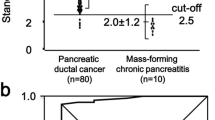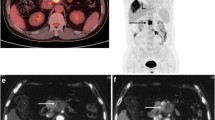Abstract
We report two cases of young women with a solid pseudo-papillary tumor of the pancreas which having cystic and hemorrhagic components with marked calcification on computed tomography and magnetic resonance imaging. F-18 fluorodeoxyglucose positron emission tomography revealed abnormally increased accumulation of F-18 fluorodeoxyglucose in the pancreas tail tumors, especially in the non-calcified solid portion of the tumors. These patients underwent elective resection of the masses and distal pancreatectomy and were diagnosed with solid pseudo-papillary tumors by histopathological analysis. There was no evidence of distant metastasis on follow-up after surgery and they showed no histopathological findings suggesting malignancy. These cases suggest that solid pseudo-papillary tumor may show high uptake of F-18 fluorodeoxyglucose.
Similar content being viewed by others
References
Lam KY, Lo CY, Fan ST. Pancreatic solid cystic-papillary tumor: clinicopathologic features in eight patients from Hong Kong and review of the literature.World J Surg 1999; 23: 1045–1050.
Huang HL, Shih SC, Chang WH, Wang TE, Chen MJ, Chan YJ. Solid-pseudopapillary tumor of the pancreas: Clinical experience and literature review.World J Gastroenterol 2005; 11 (9): 1403–1409.
Tang LH, Aydin H, Brennan MF, Klimstra DS. Clinically aggressive solid pseudopapillary tumors of the pancreas: A report of two cases with components of undifferentiated carcinoma and a comparative clinicopathologic analysis of 34 conventional cases.Am J Surg Pathol 2005; 29 (4): 512–519.
Nishihara K, Nagoshi M, Tsuneyoshi M, Yamaguchi K, Hayashi I. Papillary cystic tumors of the pancreas. Assessment of their malignant potential.Cancer 1993; 71 (1): 82–92.
Coleman KM, Doherty MC, Brigler SA. Solid-pseudopapillary tumor of the pancreas.Radiographics 2003; 23: 1644–1648.
Cantisani V, Mortele KJ, Levy A, Glickman JN, Ricci P, Passariello R, et al. MR imaging features of solid pseudo-papillary tumor of the pancreas in adult and pediatric patients.Am J Roentgenol 2003; 181 (2): 395–401.
Okaizumi S, Enomoto K, Fukunaga T, Kikuchi T, Asano T, Isono K, et al. Evaluation of the cases of benign disease with high accumulation on the examination of F-18 fluorodeoxy-glucose PET.KAKU IGAKU (Jpn J Nucl Med) 1993; 30 (12): 1439–1443.
Lee JK, Tyan YS. Detection of a solid pseudopapillary tumor of the pancreas with F-18 FDG positron emission tomography.Clin Nucl Med 2005; 30 (3): 187–188.
Nakamoto Y, Higashi T, Sakahara H, Tamaki N, Kogire M, Doi R, et al. Delayed18F-ftuoro-2-deoxy-D-glucose positron emission tomography scan for differentiation between malignant and benign lesions in the pancreas.Cancer 2000; 89: 2547–2554.
Rasmussen I, Sorensen J, Langstrom B, Haglund U. Is positron emission tomography using18F-fluorodeoxyglucose and11C-acetate valuable in diagnosing indeterminate pancreatic masses?Scand J Surg 2004; 93: 191–197.
Higashi T, Saga T, Nakamoto Y, Ishimori T, Fujimoto K, Doi R, et al. Diagnosis of pancreatic cancer using fluorine-18 fluorodeoxyglucose positron emission tomography (FDG PET)—Usefulness and limitations in “clinical reality”—.Ann Nucl Med 2003; 17: 261–279.
Nakamoto Y, Higashi T, Sakahara H, Tamaki N, Itoh K, Imamura M, Konishi J. Evaluation of pancreatic islet cell tumors by fluorine-18 fluorodeoxyglucose positron emission tomography: comparison with other modalities.Clin Nucl Med2002; 25 (2): 115–119.
Nishiguchi S, Shiomi S, Ishizu H, Iwata Y, Kurooka H, Minamitani S, et al. A case of glucagonoma with high uptake on F-18 fluorodeoxyglucose positron emission tomography.Ann Nucl Med 2001; 15 (3): 259–262.
Nakamoto Y, Saga T, Ishimori T, Higashi T, Mamede M, Okazaki K, et al. FDG-PET of autoimmune-related pancreatitis: preliminary results.Eur J Nucl Med 2000; 27 (12): 1835–1838.
Higashi T, Saga T, Nakamoto Y, Ishimori T, Mamede M, Wada M, et al. Relationship between retention index in dual-phase18F-FDG PET, and hexokinase-II and glucose transporter-1 expression in pancreatic cancer.J Nucl Med 2002; 43: 173–180.
Ito T, Noguchi Y, Satoh S, Hayashi H, Inayama Y, Kitamura H. Expression of facilitative glucose transporter isoforms in lung carcinomas: Its relation to histologie type, differentiation grade, and tumor stage.Mod Pathol 1998; 11 (5): 437–443.
Author information
Authors and Affiliations
Corresponding author
Rights and permissions
About this article
Cite this article
Sato, M., Takasaka, I., Okumura, T. et al. High F-18 fluorodeoxyglucose accumulation in solid pseudo-papillary tumors of the pancreas. Ann Nucl Med 20, 431–436 (2006). https://doi.org/10.1007/BF03027379
Received:
Accepted:
Issue Date:
DOI: https://doi.org/10.1007/BF03027379




